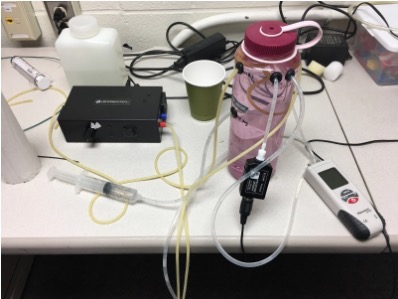Concept of Device
The presence of ischemic stroke, or the entrance of a clot to block an artery, is extremely dangerous and can lead to severe disability or death [1]. To treat such a condition in the brain, the direct aspiration thrombectomy approach has been created. This technique uses a catheter, threaded up through the arteries, to vacuum the clot out of an occluded state. It is 23 minutes faster than the next closest technique, which is known by the stent retriever method [2]. However, although the direct aspiration method is efficient, it lacks efficacy, as it is only 78% effective in comparison to the stent retriever method, which boasts 95% success [3].
Guided by Dr. Michael Froehler, we wish to improve the overall success of the direct aspiration thrombectomy. To do this, we are constructing a model that will mimic a standard cranial cavity. In order to do so, we will use an incompressible container to mimic the skull, silicone tubing to be physiologically similar to the arteries, a plastic bag to simulate intracranial pressure, and a water pump that will approximate semi-pulsatile flow. Through the model, we hope to establish two objectives:
- Intracranial pressure can change the pressure on either side of an occlusion, allowing for a better suction of the clot away from an artery. There have been estimations of ICP from arterial blood flow afterwards [4].
- Intracranial pressure manipulation has an effect on the suction force on the tip of a direct aspiration thrombectomy catheter, which is generally standard [5].
By measuring these aspects, we hope to increase the efficacy of a direct aspiration thrombectomy. Pictures and diagrams of our model are depicted below.

Figure 1: A drawing is shown that depicts the physiological model of the brain we hope to mimic.

Figure 2: The setup of our model used for obtaining all measurements. The pump is shown in black on the left, the 60 mL syringe leading into a plastic bladder within the pink 1L nalgene is the method of increasing ICP. The ICP is read by the white, red, and black pressure gauge on the right, and the pressures within the simulated middle cerebral artery are continuously outputted to a computer from the small rectangular black pressure gauge shown in the middle.
- https://www.mayoclinic.org/diseases-conditions/stroke/diagnosis-treatment/drc-20350119
- http://thejns.org/doi/abs/10.3171/2016.11.JNS161563. April 14, 2017; DOI: 10.3171/2016.11.JNS161563.
-
ADAPT FAST study: a direct aspiration first pass technique for acute stroke thrombectomy.
- Kashif, F. M., Verghese, G. C., Novak, V., Czosnyka, M., & Heldt, T. (2012). Model-Based Noninvasive Estimation of Intracranial Pressure from Cerebral Blood Flow Velocity and Arterial Pressure. Science Translational Medicine, 4(129), 129ra44. http://doi.org/10.1126/scitranslmed.3003249
- Froehler MT. Comparison of vacuum pressures and forces generated by different catheters and pumps for aspiration thrombectomy in acute ischemic stroke. Interv Neurol 2017;6:199–206.doi:10.1159/000475478
©2025 Vanderbilt University ·
Site Development: University Web Communications